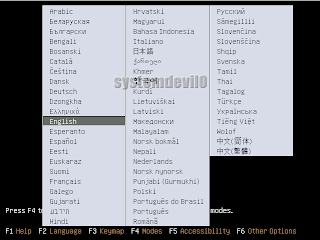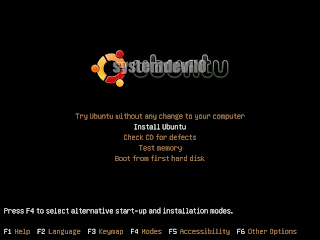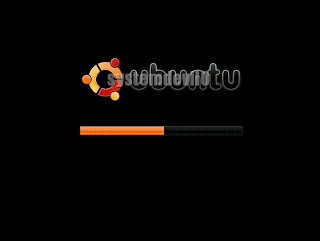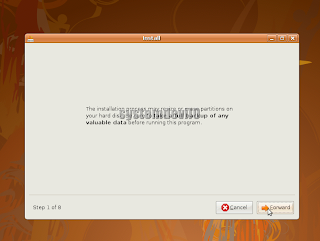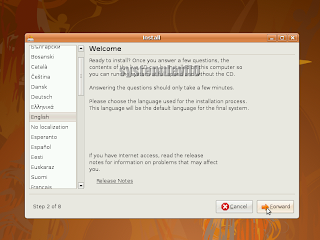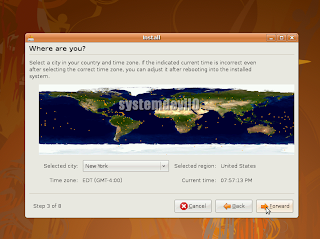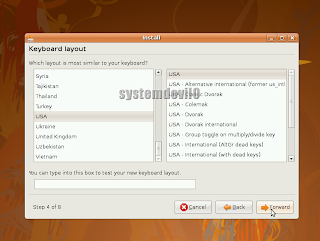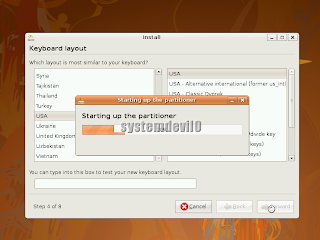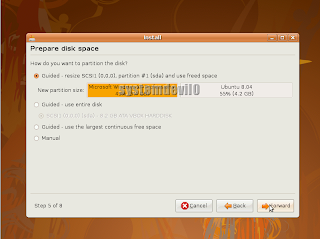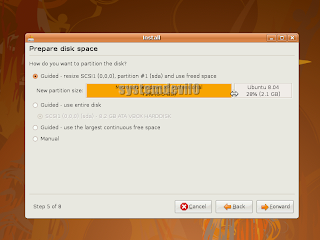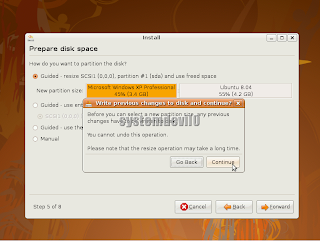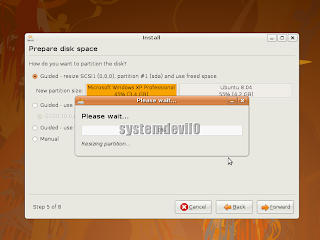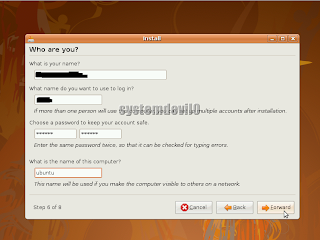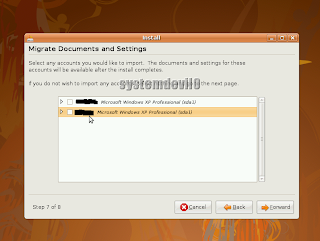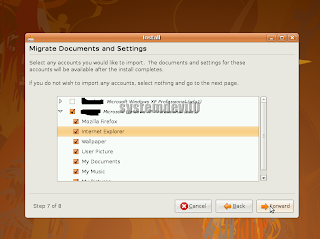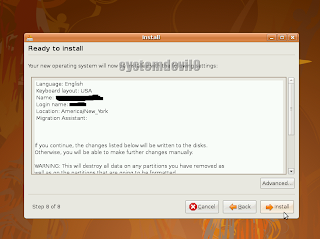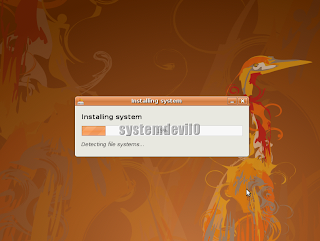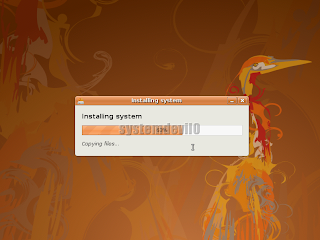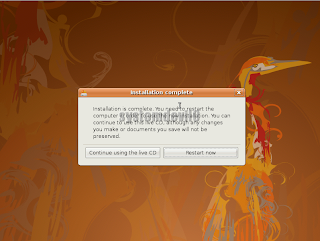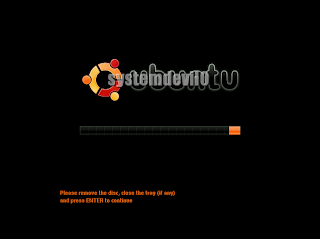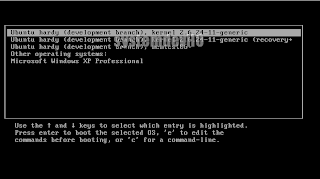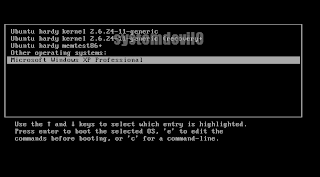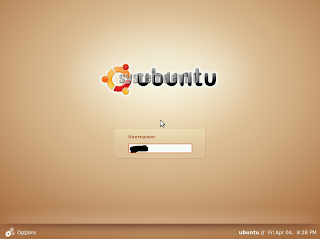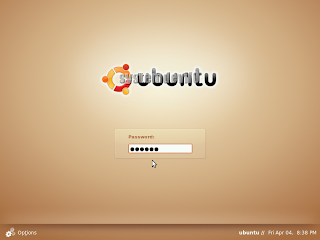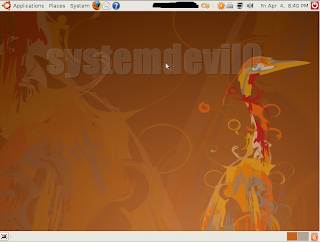Hi, today I will tell u how to convert a video from one format 2 other, in Linux.
We will use a open-source video convertor known as “ffmpeg” (don't think that bcoz it got mpeg name in it can convert only to mpeg ,it convert any video format to nay format u wish for) ffmpeg is a command line tool so here are the instruction on how to use it.
Step1: Open Terminal.
Step2: cd to the directory where the video that u want to convert is located.
Step3: type $ ffmpeg -i input.ext output.ext (note="input" reffers to file name of video to be converted, "output" reffers to file name of converted video file, "ext" reffers to video format like avi,flv,etc.)and press enter thats it ur video gets converted!!!! is int it easy??? of-course it is.
Now u may say when u do video conversion in windows u get many options like to set quality and frame rate, etc well u can do that in Linux from Terminal too!!!
If u want to convert an avi file to flv with 360 video bitrate and 128 audio bitrate then u type this in Terminal.
$ ffmpeg -i input.avi -b 360 -ab 128 output.flv
Video Help.
There are lot of preference and usage of ffmpeg available. Here are they:
usage: ffmpeg [[infile options] -i infile]... {[outfile options] outfile}...
Hyper fast Audio and Video encoder
Main options:
-L show license
-h show help
-version show version
-formats show available formats, codecs, protocols, ...
-f fmt force format
-i filename input file name
-y overwrite output files
-t duration record or transcode "duration" seconds of audio/video
-fs limit_size set the limit file size in bytes
-ss time_off set the start time offset
-itsoffset time_off set the input ts offset
-itsscale stream:scale set the input ts scale
-title string set the title
-timestamp time set the timestamp
-author string set the author
-copyright string set the copyright
-comment string set the comment
-genre string set the genre
-album string set the album
-dframes number set the number of data frames to record
-v number set the logging verbosity level
-target type specify target file type ("vcd", "svcd", "dvd", "dv", "dv50", "pal-vcd", "ntsc-svcd", ...)
-xerror exit on error
Advanced options:
-map file:stream[:syncfile:syncstream] set input stream mapping
-map_meta_data outfile:infile set meta data information of outfile from infile
-benchmark add timings for benchmarking
-dump dump each input packet
-hex when dumping packets, also dump the payload
-re read input at native frame rate
-loop_input loop (current only works with images)
-loop_output number of times to loop output in formats that support looping (0 loops forever)
-threads count thread count
-vsync video sync method
-async audio sync method
-adrift_threshold threshold audio drift threshold
-vglobal video global header storage type
-copyts copy timestamps
-shortest finish encoding within shortest input
-dts_delta_threshold threshold timestamp discontinuity delta threshold
-programid desired program number
-muxdelay seconds set the maximum demux-decode delay
-muxpreload seconds set the initial demux-decode delay
Video options:
-b bitrate set bitrate (in bits/s)
-vb bitrate set bitrate (in bits/s)
-vframes number set the number of video frames to record
-r rate set frame rate (Hz value, fraction or abbreviation)
-s size set frame size (WxH or abbreviation)
-aspect aspect set aspect ratio (4:3, 16:9 or 1.3333, 1.7777)
-croptop size set top crop band size (in pixels)
-cropbottom size set bottom crop band size (in pixels)
-cropleft size set left crop band size (in pixels)
-cropright size set right crop band size (in pixels)
-padtop size set top pad band size (in pixels)
-padbottom size set bottom pad band size (in pixels)
-padleft size set left pad band size (in pixels)
-padright size set right pad band size (in pixels)
-padcolor color set color of pad bands (Hex 000000 thru FFFFFF)
-vn disable video
-vcodec codec force video codec ('copy' to copy stream)
-sameq use same video quality as source (implies VBR)
-pass n select the pass number (1 or 2)
-passlogfile file select two pass log file name
-newvideo add a new video stream to the current output stream
Advanced Video options:
-pix_fmt format set pixel format, 'list' as argument shows all the pixel formats supported
-intra use only intra frames
-vdt n discard threshold
-qscale q use fixed video quantizer scale (VBR)
-rc_override override rate control override for specific intervals
-me_threshold threshold motion estimaton threshold
-deinterlace deinterlace pictures
-psnr calculate PSNR of compressed frames
-vstats dump video coding statistics to file
-vstats_file file dump video coding statistics to file
-vhook module insert video processing module
-intra_matrix matrix specify intra matrix coeffs
-inter_matrix matrix specify inter matrix coeffs
-top top=1/bottom=0/auto=-1 field first
-dc precision intra_dc_precision
-vtag fourcc/tag force video tag/fourcc
-qphist show QP histogram
-vbsf bitstream_filter
-vpre preset
Audio options:
-ab bitrate set bitrate (in bits/s)
-aframes number set the number of audio frames to record
-aq quality set audio quality (codec-specific)
-ar rate set audio sampling rate (in Hz)
-ac channels set number of audio channels
-an disable audio
-acodec codec force audio codec ('copy' to copy stream)
-vol volume change audio volume (256=normal)
-newaudio add a new audio stream to the current output stream
-alang code set the ISO 639 language code (3 letters) of the current audio stream
Advanced Audio options:
-atag fourcc/tag force audio tag/fourcc
-sample_fmt format set sample format, 'list' as argument shows all the sample formats supported
-absf bitstream_filter
-apre preset
Subtitle options:
-sn disable subtitle
-scodec codec force subtitle codec ('copy' to copy stream)
-newsubtitle add a new subtitle stream to the current output stream
-slang code set the ISO 639 language code (3 letters) of the current subtitle stream
-sbsf bitstream_filter
-spre preset
Audio/Video grab options:
-vc channel set video grab channel (DV1394 only)
-tvstd standard set television standard (NTSC, PAL (SECAM))
-isync sync read on input
AVCodecContext AVOptions:
-b
-ab
-bt
-flags
mv4 E.V.. use four motion vector by macroblock (mpeg4)
obmc E.V.. use overlapped block motion compensation (h263+)
qpel E.V.. use 1/4 pel motion compensation
loop E.V.. use loop filter
gmc E.V.. use gmc
mv0 E.V.. always try a mb with mv=<0,0>
part E.V.. use data partitioning
gray EDV.. only decode/encode grayscale
psnr E.V.. error[?] variables will be set during encoding
naq E.V.. normalize adaptive quantization
ildct E.V.. use interlaced dct
low_delay EDV.. force low delay
alt E.V.. enable alternate scantable (mpeg2/mpeg4)
trell E.V.. use trellis quantization
global_header E.VA. place global headers in extradata instead of every keyframe
bitexact EDVAS use only bitexact stuff (except (i)dct)
aic E.V.. h263 advanced intra coding / mpeg4 ac prediction
umv E.V.. use unlimited motion vectors
cbp E.V.. use rate distortion optimization for cbp
qprd E.V.. use rate distortion optimization for qp selection
aiv E.V.. h263 alternative inter vlc
slice E.V..
ilme E.V.. interlaced motion estimation
scan_offset E.V.. will reserve space for svcd scan offset user data
cgop E.V.. closed gop
-me_method
zero E.V.. zero motion estimation (fastest)
full E.V.. full motion estimation (slowest)
epzs E.V.. EPZS motion estimation (default)
esa E.V.. esa motion estimation (alias for full)
tesa E.V.. tesa motion estimation
dia E.V.. dia motion estimation (alias for epzs)
log E.V.. log motion estimation
phods E.V.. phods motion estimation
x1 E.V.. X1 motion estimation
hex E.V.. hex motion estimation
umh E.V.. umh motion estimation
iter E.V.. iter motion estimation
-me
zero E.V.. zero motion estimation (fastest)
full E.V.. full motion estimation (slowest)
epzs E.V.. EPZS motion estimation (default)
esa E.V.. esa motion estimation (alias for full)
tesa E.V.. tesa motion estimation
dia E.V.. dia motion estimation (alias for epzs)
log E.V.. log motion estimation
phods E.V.. phods motion estimation
x1 E.V.. X1 motion estimation
hex E.V.. hex motion estimation
umh E.V.. umh motion estimation
iter E.V.. iter motion estimation
-g
-cutoff
-frame_size
-qcomp
-qblur
-qmin
-qmax
-qdiff
-bf
-b_qfactor
-rc_strategy
-b_strategy
-hurry_up
-ps
-bug
autodetect .DV..
old_msmpeg4 .DV.. some old lavc generated msmpeg4v3 files (no autodetection)
xvid_ilace .DV.. Xvid interlacing bug (autodetected if fourcc==XVIX)
ump4 .DV.. (autodetected if fourcc==UMP4)
no_padding .DV.. padding bug (autodetected)
amv .DV..
ac_vlc .DV.. illegal vlc bug (autodetected per fourcc)
qpel_chroma .DV..
std_qpel .DV.. old standard qpel (autodetected per fourcc/version)
qpel_chroma2 .DV..
direct_blocksize .DV.. direct-qpel-blocksize bug (autodetected per fourcc/version)
edge .DV.. edge padding bug (autodetected per fourcc/version)
hpel_chroma .DV..
dc_clip .DV..
ms .DV.. workaround various bugs in microsofts broken decoders
-lelim
-celim
-strict
very EDV.. strictly conform to a older more strict version of the spec or reference software
strict EDV.. strictly conform to all the things in the spec no matter what consequences
normal EDV..
inofficial EDV.. allow inofficial extensions
experimental EDV.. allow non standardized experimental things
-b_qoffset
-er
careful .DV..
compliant .DV..
aggressive .DV..
very_aggressive .DV..
-mpeg_quant
-qsquish
-rc_qmod_amp
-rc_qmod_freq
-rc_eq
-maxrate
-minrate
-bufsize
-rc_buf_aggressivity
-i_qfactor
-i_qoffset
-rc_init_cplx
-dct
auto E.V.. autoselect a good one (default)
fastint E.V.. fast integer
int E.V.. accurate integer
mmx E.V..
mlib E.V..
altivec E.V..
faan E.V.. floating point AAN DCT
-lumi_mask
-tcplx_mask
-scplx_mask
-p_mask
-dark_mask
-idct
auto EDV..
int EDV..
simple EDV..
simplemmx EDV..
libmpeg2mmx EDV..
ps2 EDV..
mlib EDV..
arm EDV..
altivec EDV..
sh4 EDV..
simplearm EDV..
simplearmv5te EDV..
simplearmv6 EDV..
h264 EDV..
vp3 EDV..
ipp EDV..
xvidmmx EDV..
faani EDV.. floating point AAN IDCT
-ec
guess_mvs .DV.. iterative motion vector (MV) search (slow)
deblock .DV.. use strong deblock filter for damaged MBs
-pred
left E.V..
plane E.V..
median E.V..
-aspect
-debug
pict .DV.. picture info
rc E.V.. rate control
bitstream .DV..
mb_type .DV.. macroblock (MB) type
qp .DV.. per-block quantization parameter (QP)
mv .DV.. motion vector
dct_coeff .DV..
skip .DV..
startcode .DV..
pts .DV..
er .DV.. error resilience
mmco .DV.. memory management control operations (H.264)
bugs .DV..
vis_qp .DV.. visualize quantization parameter (QP), lower QP are tinted greener
vis_mb_type .DV.. visualize block types
buffers .DV.. picture buffer allocations
-vismv
pf .DV.. forward predicted MVs of P-frames
bf .DV.. forward predicted MVs of B-frames
bb .DV.. backward predicted MVs of B-frames
-mb_qmin
-mb_qmax
-cmp
sad E.V.. sum of absolute differences, fast (default)
sse E.V.. sum of squared errors
satd E.V.. sum of absolute Hadamard transformed differences
dct E.V.. sum of absolute DCT transformed differences
psnr E.V.. sum of squared quantization errors (avoid, low quality)
bit E.V.. number of bits needed for the block
rd E.V.. rate distortion optimal, slow
zero E.V.. 0
vsad E.V.. sum of absolute vertical differences
vsse E.V.. sum of squared vertical differences
nsse E.V.. noise preserving sum of squared differences
w53 E.V.. 5/3 wavelet, only used in snow
w97 E.V.. 9/7 wavelet, only used in snow
dctmax E.V..
chroma E.V..
-subcmp
sad E.V.. sum of absolute differences, fast (default)
sse E.V.. sum of squared errors
satd E.V.. sum of absolute Hadamard transformed differences
dct E.V.. sum of absolute DCT transformed differences
psnr E.V.. sum of squared quantization errors (avoid, low quality)
bit E.V.. number of bits needed for the block
rd E.V.. rate distortion optimal, slow
zero E.V.. 0
vsad E.V.. sum of absolute vertical differences
vsse E.V.. sum of squared vertical differences
nsse E.V.. noise preserving sum of squared differences
w53 E.V.. 5/3 wavelet, only used in snow
w97 E.V.. 9/7 wavelet, only used in snow
dctmax E.V..
chroma E.V..
-mbcmp
sad E.V.. sum of absolute differences, fast (default)
sse E.V.. sum of squared errors
satd E.V.. sum of absolute Hadamard transformed differences
dct E.V.. sum of absolute DCT transformed differences
psnr E.V.. sum of squared quantization errors (avoid, low quality)
bit E.V.. number of bits needed for the block
rd E.V.. rate distortion optimal, slow
zero E.V.. 0
vsad E.V.. sum of absolute vertical differences
vsse E.V.. sum of squared vertical differences
nsse E.V.. noise preserving sum of squared differences
w53 E.V.. 5/3 wavelet, only used in snow
w97 E.V.. 9/7 wavelet, only used in snow
dctmax E.V..
chroma E.V..
-ildctcmp
sad E.V.. sum of absolute differences, fast (default)
sse E.V.. sum of squared errors
satd E.V.. sum of absolute Hadamard transformed differences
dct E.V.. sum of absolute DCT transformed differences
psnr E.V.. sum of squared quantization errors (avoid, low quality)
bit E.V.. number of bits needed for the block
rd E.V.. rate distortion optimal, slow
zero E.V.. 0
vsad E.V.. sum of absolute vertical differences
vsse E.V.. sum of squared vertical differences
nsse E.V.. noise preserving sum of squared differences
w53 E.V.. 5/3 wavelet, only used in snow
w97 E.V.. 9/7 wavelet, only used in snow
dctmax E.V..
chroma E.V..
-dia_size
-last_pred
-preme
-precmp
sad E.V.. sum of absolute differences, fast (default)
sse E.V.. sum of squared errors
satd E.V.. sum of absolute Hadamard transformed differences
dct E.V.. sum of absolute DCT transformed differences
psnr E.V.. sum of squared quantization errors (avoid, low quality)
bit E.V.. number of bits needed for the block
rd E.V.. rate distortion optimal, slow
zero E.V.. 0
vsad E.V.. sum of absolute vertical differences
vsse E.V.. sum of squared vertical differences
nsse E.V.. noise preserving sum of squared differences
w53 E.V.. 5/3 wavelet, only used in snow
w97 E.V.. 9/7 wavelet, only used in snow
dctmax E.V..
chroma E.V..
-pre_dia_size
-subq
-me_range
-ibias
-pbias
-coder
vlc E.V.. variable length coder / huffman coder
ac E.V.. arithmetic coder
raw E.V.. raw (no encoding)
rle E.V.. run-length coder
deflate E.V.. deflate-based coder
-context
-mbd
simple E.V.. use mbcmp (default)
bits E.V.. use fewest bits
rd E.V.. use best rate distortion
-sc_threshold
-lmin
-lmax
-nr
-rc_init_occupancy
-inter_threshold
-flags2
fast E.V.. allow non spec compliant speedup tricks
sgop E.V.. strictly enforce gop size
noout E.V.. skip bitstream encoding
local_header E.V.. place global headers at every keyframe instead of in extradata
bpyramid E.V.. allows B-frames to be used as references for predicting
wpred E.V.. weighted biprediction for b-frames (H.264)
mixed_refs E.V.. one reference per partition, as opposed to one reference per macroblock
dct8x8 E.V.. high profile 8x8 transform (H.264)
fastpskip E.V.. fast pskip (H.264)
aud E.V.. access unit delimiters (H.264)
brdo E.V.. b-frame rate-distortion optimization
skiprd E.V.. RD optimal MB level residual skipping
ivlc E.V.. intra vlc table
drop_frame_timecode E.V..
non_linear_q E.V.. use non linear quantizer
reservoir E..A. use bit reservoir
-error
-antialias
auto .DV..
fastint .DV..
int .DV..
float .DV..
-qns
-threads
-mb_threshold
-dc
-nssew
-skip_top
-skip_bottom
-profile
unknown E.VA.
aac_main E..A.
aac_low E..A.
aac_ssr E..A.
aac_ltp E..A.
-level
unknown E.VA.
-lowres
-skip_threshold
-skip_factor
-skip_exp
-skipcmp
sad E.V.. sum of absolute differences, fast (default)
sse E.V.. sum of squared errors
satd E.V.. sum of absolute Hadamard transformed differences
dct E.V.. sum of absolute DCT transformed differences
psnr E.V.. sum of squared quantization errors (avoid, low quality)
bit E.V.. number of bits needed for the block
rd E.V.. rate distortion optimal, slow
zero E.V.. 0
vsad E.V.. sum of absolute vertical differences
vsse E.V.. sum of squared vertical differences
nsse E.V.. noise preserving sum of squared differences
w53 E.V.. 5/3 wavelet, only used in snow
w97 E.V.. 9/7 wavelet, only used in snow
dctmax E.V..
chroma E.V..
-border_mask
-mblmin
-mblmax
-mepc
-skip_loop_filter
none .DV..
default .DV..
noref .DV..
bidir .DV..
nokey .DV..
all .DV..
-skip_idct
none .DV..
default .DV..
noref .DV..
bidir .DV..
nokey .DV..
all .DV..
-skip_frame
none .DV..
default .DV..
noref .DV..
bidir .DV..
nokey .DV..
all .DV..
-bidir_refine
-brd_scale
-crf
-cqp
-keyint_min
-refs
-chromaoffset
-bframebias
-trellis
-directpred
-complexityblur
-deblockalpha
-deblockbeta
-partitions
parti4x4 E.V..
parti8x8 E.V..
partp4x4 E.V..
partp8x8 E.V..
partb8x8 E.V..
-sc_factor
-mv0_threshold
-b_sensitivity
-compression_level
-use_lpc
-lpc_coeff_precision
-min_prediction_order
-max_prediction_order
-prediction_order_method
-min_partition_order
-max_partition_order
-timecode_frame_start
-request_channels
-drc_scale
AVFormatContext AVOptions:
-probesize
-muxrate
-packetsize
-fflags
ignidx .D... ignore index
genpts .D... generate pts
-track
-year
-analyzeduration
-cryptokey
-indexmem
-rtbufsize
-fdebug
ts ED...
SWScaler AVOptions:
-sws_flags
fast_bilinear E.V.. fast bilinear
bilinear E.V.. bilinear
bicubic E.V.. bicubic
experimental E.V.. experimental
neighbor E.V.. nearest neighbor
area E.V.. averaging area
bicublin E.V.. luma bicubic, chroma bilinear
gauss E.V.. gaussian
sinc E.V.. sinc
lanczos E.V.. lanczos
spline E.V.. natural bicubic spline
print_info E.V.. print info
accurate_rnd E.V.. accurate rounding
mmx E.V.. MMX SIMD acceleration
mmx2 E.V.. MMX2 SIMD acceleration
3dnow E.V.. 3DNOW SIMD acceleration
altivec E.V.. AltiVec SIMD acceleration
bfin E.V.. Blackfin SIMD acceleration
full_chroma_int E.V.. full chroma interpolation
full_chroma_inp E.V.. full chroma input
bitexact E.V..






